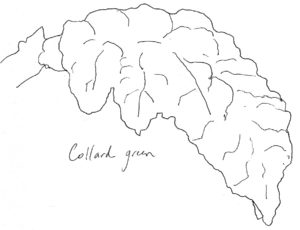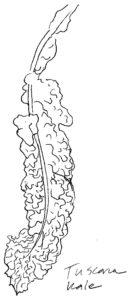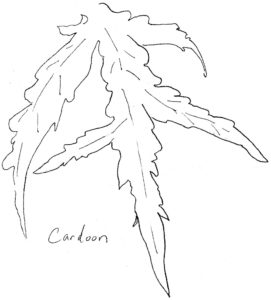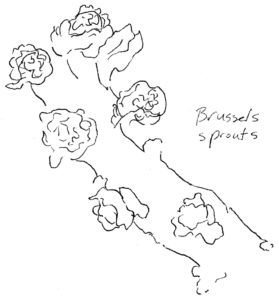Text and Drawings by Abraham Storer
Jean Horner has been working on farms and in gardens since she was 18, after an earlier gig as a professional polo groom. These days she tends a large garden at her Truro house. It’s full of greens this time of year. She eats from the garden all year round, growing over half of the food she consumes. “I always loved to grow stuff,” she says.
 Q: What’s your garden like now that there’s been a frost?
Q: What’s your garden like now that there’s been a frost?
Once the frost comes, I breathe a sigh of relief. I don’t have to think about certain things like gathering tomatoes or checking peppers. The greens continue through the winter, and we eat them with every meal.
 Most lettuce can take some frost. I used to grow a variety called Kweik; now I’m growing North Pole, which also does well in the cold. I planted it around the first of September.
Most lettuce can take some frost. I used to grow a variety called Kweik; now I’m growing North Pole, which also does well in the cold. I planted it around the first of September.
Collard greens are a stellar crop to grow all winter on the Cape. They’re a true perennial, and they just always come back. When the collard greens are poking through the snow we come out and pick it.
Q: Can you tell me about using cover crops?
A cover crop stops erosion, which is the enemy of any farmer or gardener. But if I’m going to plant a cover crop, I want to plant food that I can eat. I have some purple-top turnips — we eat the greens. I also use arugula, and it all gets eaten. Same with spinach, and it goes right through the winter.
Q: How do you enrich your soil?
I constantly work on my soil. I have a method based on Ruth Stout’s ideas on mulching in place. Everyone should read her book, Gardening Without Work. She put hay on top of the soil, but it can be any organic material. She didn’t mix it in. Everything you mix in will draw nitrogen to it to break it down, which takes away from existing plants.
I go get hay, get seaweed, and beg people for their leaves. I just keep adding. It’s best to have a diverse range of organic material. Nothing gets hauled out of the garden. Everything stays here. I just chop and drop. Here is a pile of stalks from zinnias and cosmos. There are seeds in there and next year they’ll come up here.
Q: I see garlic greens sprouting. When did you plant your garlic?
In October. I think the earlier you plant it, the better it is. I plant everything by the Moon. I have garlic that I’ve had for 38 years. When I harvest the garlic, I always cure it and replant some.
 Certain vegetables need to be cured for keeping. The old-timers knew that. You leave them out to dry for a few days and periodically turn them before putting them away. Potatoes, sweet potatoes, garlic, pumpkins, winter squash should all be cured.
Certain vegetables need to be cured for keeping. The old-timers knew that. You leave them out to dry for a few days and periodically turn them before putting them away. Potatoes, sweet potatoes, garlic, pumpkins, winter squash should all be cured.
Q: How do you use your greenhouse?
It’s important to have greenhouses or gardens near the house. My greenhouse is right out the front door, so it’s always on my radar. In winter, the outdoor garden is the grand experiment; the greenhouse is the insurance.
I always plant something in season there. I still have a few tomatoes. I’ll start fall plants in the garden and then transfer them to the greenhouse. And in the spring, I start seeds in the greenhouse.
Q: Do you save seeds?
I let plants go to seed, which can be a hassle because I want that room for something else. I cut seed stalks off and put them in paper bags in the attic to dry for a month or so. Then, I deal with the seeds when people come by and we’re sitting on the porch. Separating the seed from the chaff is a meditative activity.
Q: Do you have any advice for someone starting a garden?
People give up too early. Failures are inevitable. People think a garden is supposed to be the same from year to year. It’s always different — that’s my mantra.



